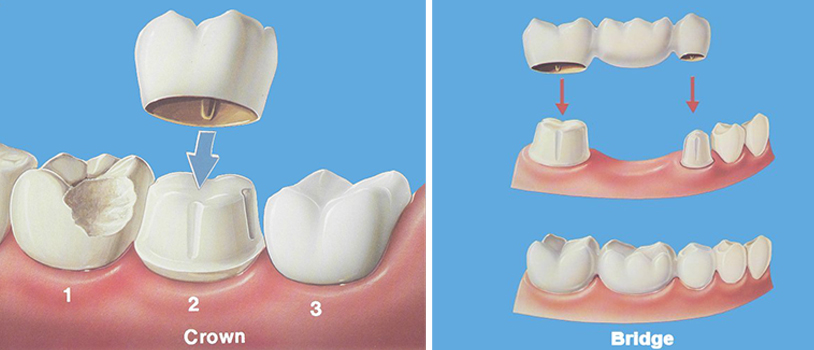Dental crowns and bridges. Crowns and bridges are a fixed solution to missing or damaged teeth. This restorative procedure uses prosthetic devices to return your smile to its natural state. A crown is used when the tooth structure is damaged or fractured. A bridge is used when one or more teeth are missing.
What is the difference between a crown and a bridge? ... Essentially, a crown is a cap used to restore a tooth to its original appearance and prevent further damage or decay. A bridge, unlike a crown, utilizes existing teeth to fill in an area left vacant by a missing tooth.
Both crowns and most bridges are fixed prosthetic devices. Unlike removable devices such as dentures, which you can take out and clean daily, crowns and bridges are cemented onto existing teeth or implants, and can only be removed by a dentist.
Different Types of Crowns
Ceramic Crowns – Ceramic crowns are porcelain-based fillings, recommended for restoring the front teeth for better color blending. A dentist who recommends this kind of crown might need to remove some of the tooth structure to attach the ceramic crown to the tooth. The material overtime may become brittle from heavy biting and depending on how it’s installed, can be resistant to wear.
Porcelain Crowns – Porcelain crowns fused to metal, in simplest terms. The porcelain is usually connected to the outside of the metal to provide a good seal, and give strength to the teeth. Your dentist might also need to remove parts of the tooth to install the crown.
Gold Alloy Crowns – Gold, silver, or platinum and other metals make up the consistency of these crowns. Gold alloys are typically more resistant to wear and fracturing, and the material is bio compatible.
Base Metal Alloy Crowns – Metals, such as titanium, copper, or zinc, still provide strength and high resistance to corrosion, even while they’re not noble. With base metal crowns, the dentist should try and remove as little of the healthy tooth as possible to help adhere the crown to the tooth.
What are dental bridges?
Bridges, on the other hand, are a collection of false teeth held in place by teeth on either side of the gap. For those with multiple missing teeth, bridges can provide a viable solution. Bridges can replace one tooth, or replace multiple teeth, and depending on the material, can give off a natural look to your teeth. Teeth with decay, physical damage, and abscess are most often treated with these kinds of appliances.
Types of Bridges
Traditional Bridges – The most popular form of bridges, the teeth on either side of the bridge are covered with crowns, and the false teeth bridge is attached to these crowns.
Cantilever Bridges – Similar to tradition bridges, these are held in place by a dental crown on only one tooth, allowing you to have one natural tooth to hold in place the bridge. These type of bridges are usually recommended when your missing a back tooth or several back teeth.
Maryland Bridges – Unlike traditional and cantilever, it incorporates metal or porcelain frames and then bond those frames to the backs of the adjacent teeth.
Composite Bridges – Composite bridges focus on using a tooth filling to recreate the adjacent missing teeth, and then



